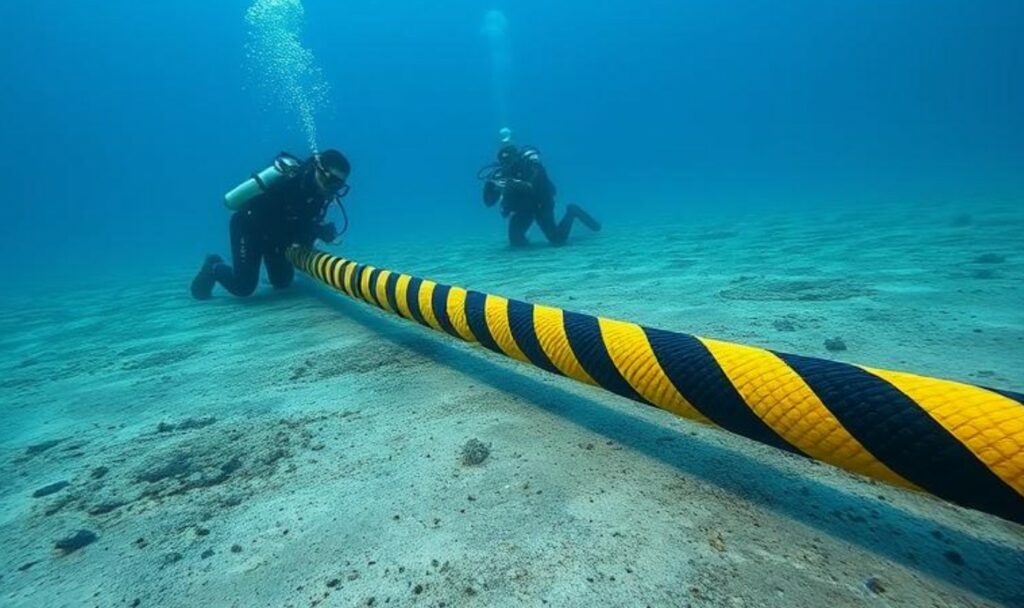
The undersea cables connecting the UK to the outside world are vital to the country, with transactions amounting to £220 billion every day. The Joint Committee on National Security Strategy (JCNSS) has called on the government to more actively protect cable infrastructure, the Register reports . A report published in September called the government “overly timid” in its approach to this issue.
The report notes that 64 cables connect the country to the outside world , carrying the vast majority of traffic, while satellite traffic is negligible . Furthermore, digital backbones are quite difficult to protect: approximately 200 cables break each year worldwide due to “natural” causes. The further from the coast, the weaker their security becomes, while operators rely on installations at greater depths far from the coast.
Some regions have redundancies to cope with disruptions. For example, 75% of the UK’s transatlantic traffic travels on just two cables with landing stations in Cornwall , but the country has sufficient additional infrastructure to divert traffic in the event of an incident. However, connection problems with the rest of Europe could cause much more serious problems, so greater attention should be paid to the ability to cope with unexpected shocks.
Russia is mentioned as a potential adversary, allegedly having been exploring the possibility of information warfare aimed at cutting off certain territories from telecommunications for many years. Russia is reported to have the technical means to detect cables at great depths. However, in practice, damage occurs more often at relatively shallow depths and does not require specialized equipment. For example, in November 2024, the Yi Peng 3 vessel damaged two cables between Sweden and Lithuania with its anchor. A month later, the Eagle S vessel damaged an electricity cable and three telecommunications cables connecting Finland and Estonia. Cables in the Red Sea have also been damaged by anchors on numerous occasions.
One of the main problems with such accidents is the difficulty in proving their intentionality, especially since experts still disagree on the nature of the accidents. However, a precedent has already been set in Taiwan. The JCNSS believes it is necessary to be prepared for such accidents, regardless of their nature, especially considering that, according to TeleGeography , the need for new cables will lead to a 48% increase in their length by 2040 , and the annual volume of repair work will increase by 36% by 2040. There are 62 cable-laying and repair vessels worldwide, enough to last 15 years.
According to the JNSS , the UK does not have its own repair ships, and access to some cables is expensive and difficult, with a ship capable of working on only one cable at a time. The committee recommends establishing a UK repair ship by 2030 and training its crew at the Navy . In peacetime, it could be leased to private companies. The JCNSS argues that the situation over the next decade could be unpredictable, leaving the UK vulnerable. Even a public declaration of robust defense preparations could reduce the likelihood of sabotage.
Furthermore, it is recommended that risk scenarios include the possibility of a coordinated campaign against cables and landing stations located in remote areas of the UK. Detailed studies of the potential for cable detachment are also recommended. The government states that it has already adopted comprehensive protection measures, including the Baltic Sentry initiative, the updating of the Undersea Cable Protection Act of 1885 , and the purchase of a vessel for cable monitoring and protection, and the scenario presented by the JCNSS is unlikely.
In any case, some experts note a growing interest among governments and private companies in examining the extent to which their activities depend on the integrity of communications. The rapid growth of digital sovereignty laws is likely linked to a desire to improve the resilience of information infrastructures. However, such initiatives have many negative consequences. For example, locating computing power and data on one’s own territory, rather than where it is economically viable, inevitably leads to increased costs.
Follow us on Google News to receive daily updates on cybersecurity. Contact us if you would like to report news, insights or content for publication.
